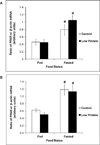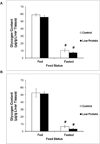Decreased liver triglyceride content in adult rats exposed to protein restriction during gestation and lactation: role of hepatic triglyceride utilization
- PMID: 25641378
- PMCID: PMC4401994
- DOI: 10.1111/1440-1681.12359
Decreased liver triglyceride content in adult rats exposed to protein restriction during gestation and lactation: role of hepatic triglyceride utilization
Abstract
We have previously demonstrated that protein restriction throughout gestation and lactation reduces liver triglyceride content in adult rat offspring. However, the mechanisms mediating the decrease in liver triglyceride content are not understood. The aim of the current study was to use a new group of pregnant animals and their offspring and determine the contribution of increased triglyceride utilization via the hepatic fatty-acid oxidation and triglyceride secretory pathways to the reduction in liver triglyceride content. Pregnant Sprague-Dawley rats received either a control or a low protein diet throughout pregnancy and lactation. Pups were weaned onto laboratory chow on day 28 and killed on day 65. Liver triglyceride content was reduced in male, but not female, low-protein offspring, both in the fed and fasted states. The reduction was accompanied by a trend towards higher liver carnitine palmitoyltransferase-1a activity, suggesting increased fatty-acid transport into the mitochondrial matrix. However, medium-chain acyl coenzyme A dehydrogenase activity within the mitochondrial matrix, expression of nuclear peroxisome proliferator activated receptor-α, and plasma levels of β-hydroxybutyrate were similar between low protein and control offspring, indicating a lack of change in fatty-acid oxidation. Hepatic triglyceride secretion, assessed by blocking peripheral triglyceride utilization and measuring serum triglyceride accumulation rate, and the activity of microsomal transfer protein, were similar between low protein and control offspring. Because enhanced triglyceride utilization is not a significant contributor, the decrease in liver triglyceride content in male low-protein offspring is likely due to alterations in liver fatty-acid transport or triglyceride biosynthesis.
Keywords: fatty-acid oxidation; hepatic triglyceride secretion; liver glycogen content; liver triglyceride content.
© 2015 Wiley Publishing Asia Pty Ltd.
Figures





Similar articles
-
Maternal protein restriction during pregnancy and lactation in rats imprints long-term reduction in hepatic lipid content selectively in the male offspring.Nutr Res. 2010 Jun;30(6):410-7. doi: 10.1016/j.nutres.2010.05.008. Nutr Res. 2010. PMID: 20650349
-
Decreased liver triglyceride content in adult rats exposed to protein restriction during gestation and lactation: roles of hepatic lipogenesis and lipid utilization in muscle and adipose tissue.Can J Physiol Pharmacol. 2019 Oct;97(10):952-962. doi: 10.1139/cjpp-2018-0646. Epub 2019 Jun 25. Can J Physiol Pharmacol. 2019. PMID: 31238009
-
Methionine restriction prevents the progression of hepatic steatosis in leptin-deficient obese mice.Metabolism. 2013 Nov;62(11):1651-61. doi: 10.1016/j.metabol.2013.06.012. Epub 2013 Aug 5. Metabolism. 2013. PMID: 23928105
-
[Lactation and alcohol: clinical and nutritional effects].Arch Latinoam Nutr. 2004 Mar;54(1):25-35. Arch Latinoam Nutr. 2004. PMID: 15332353 Review. Portuguese.
-
Epigenetic Switching and Neonatal Nutritional Environment.Adv Exp Med Biol. 2018;1012:19-25. doi: 10.1007/978-981-10-5526-3_3. Adv Exp Med Biol. 2018. PMID: 29956191 Review.
Cited by
-
Developmental Programming in Animal Models: Critical Evidence of Current Environmental Negative Changes.Reprod Sci. 2023 Feb;30(2):442-463. doi: 10.1007/s43032-022-00999-8. Epub 2022 Jun 13. Reprod Sci. 2023. PMID: 35697921 Free PMC article. Review.
-
Maternal Macronutrient Consumption and the Developmental Origins of Metabolic Disease in the Offspring.Int J Mol Sci. 2017 Jul 6;18(7):1451. doi: 10.3390/ijms18071451. Int J Mol Sci. 2017. PMID: 28684678 Free PMC article. Review.
-
Developmental Origins of Cardiometabolic Diseases: Role of the Maternal Diet.Front Physiol. 2016 Nov 16;7:504. doi: 10.3389/fphys.2016.00504. eCollection 2016. Front Physiol. 2016. PMID: 27899895 Free PMC article. Review.
-
Dehydro-Tocotrienol-β Counteracts Oxidative-Stress-Induced Diabetes Complications in db/db Mice.Antioxidants (Basel). 2021 Jul 2;10(7):1070. doi: 10.3390/antiox10071070. Antioxidants (Basel). 2021. PMID: 34356303 Free PMC article.
-
Transcriptional regulation of N6-methyladenosine orchestrates sex-dimorphic metabolic traits.Nat Metab. 2021 Jul;3(7):940-953. doi: 10.1038/s42255-021-00427-2. Epub 2021 Jul 19. Nat Metab. 2021. PMID: 34282353 Free PMC article.
References
-
- Qasem RJ, Cherala G, D'Mello AP. Maternal protein restriction during pregnancy and lactation in rats imprints long-term reduction in hepatic lipid content selectively in the male offspring. Nutr.Res. 2010;30:410–417. - PubMed
-
- Lim K, Armitage JA, Stefanidis A, Oldfield BJ, Black MJ. IUGR in the absence of postnatal "catch-up" growth leads to improved whole body insulin sensitivity in rat offspring. Pediatr. Res. 2011;70:339–344. - PubMed
-
- Desai M, Gayle D, Babu J, Ross MG. Programmed obesity in intrauterine growth-restricted newborns: modulation by newborn nutrition. Am. J. Physiol. Regu.l Integr. Comp. Physiol. 2005;288:R91–R96. - PubMed
Publication types
MeSH terms
Substances
Grants and funding
LinkOut - more resources
Full Text Sources
Other Literature Sources
Medical

